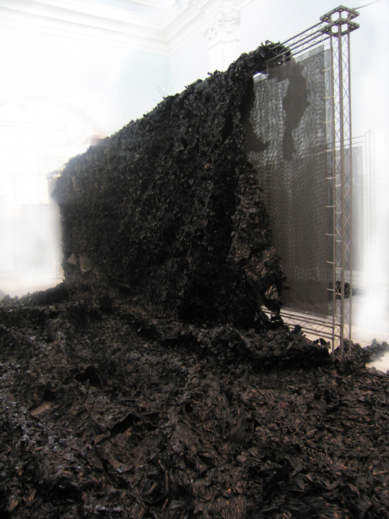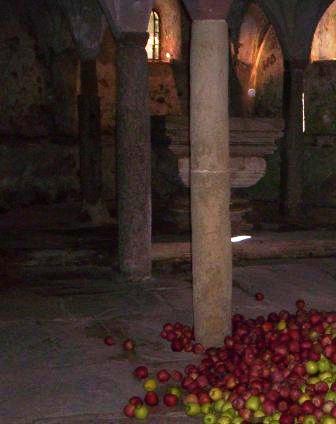
|
|
Luigi
Stoisa Thanks to the new use of tar as means of expression, Luigi Stoisa is well known on an international scale. He persisted in his research without subordinating aesthetic to uncontrolled experimentalism driven on by a post-modern yearning of eclectic venture among possible techniques. Analysing the materials employed by the Artist, one can appreciate the work of his long career. The chaotic levelling, due to both gravity and desegregation, represents the implicit principle of his tar melt-down. The above physical forces aim at the greatest dispersion of energy over a single surface, a complete and unlimited magma. One of his most famous masterpieces, now at Galleria d’ Arte Moderna in Turin, depicts the liquefied and altered Narcissus’ physiognomy, in the style of Caravaggio, a fluid tar flowing out from a damaged barrel. In Caravaggio’s painting, the legendary Narcissus, in love with his own beauty, is mirrored in the motionless, dark, shiny surface of a shore. The semicircle delineated by the hero’s shoulders and arms appears doubled by the reflecting effect. Moreover, in Caravaggio’s work the skin of the knee unexpectedly emerges from darkness like a nuclear mass shining in the inner circle. It produces an esoteric abstract symbol of subjectivity forestalling a romantic idealism, a universal ego perfectly achieved. Purposely painting the Narcissus’ face on fluid, it turned out distorted, thus widening a static subject to an aesthetical effect of criticism which frustrates the monumentality of ego. The classical statues plunged into bituminous sewage induce the critics towards a perfect Dadaist current (see moustached Gioconda by Duchamps) resulting in a new baroque code for the unbanished beauty, unlike the historical avant-garde principles. In more than one sense Stoisa’s expression is metaphorical. A theory of linguistic philosophy relates to the known world like a declaration of opinions and words. From centre to periphery, the instable platform of our knowledge is shaken by impacts establishing action. These shocks, like fluid waves generated by earthquakes, cause vibrations moving our linguistic logics and notions. The waves can be identified with words almost magical standing at the extreme borders of our linguistic richness. Enchanted forests surrounding the medieval village. Ferdinand de Saussure, father of structuralism, differentiated both grammatical and syntactic abstractions, which he called Langue, from the natural usual procedure of Parole, which develops the transformation of language morphology and semantics. This transformation implies an almost metaphysical need caused by an essential difference between the meaning of sign and the sense of reality. For de Saussure the above difference is represented by the rhetoric symbol of metaphors. Our perception produces analogical relations and resemblances which generate these differences coming from ignorance, popular wisdom, as in proverbs or in the symbolic intention of poetry. Stoisa’s works create metaphors and images pertaining to metaphor, metaphors of metaphor, images of symbols as well as symbols of images, in a vertigo of images. For a better comprehension of the Artist’s work, we further analyse the media and observe the alterations of plenum with the means of electricity according to Marshall McLuhan’s interpretation in his “Gli Strumenti del Comunicare” (instruments-media of communication). For McLuhan, electricity, as means of communication, becomes the quintessence of his saying “il medium è il messaggio” (media are the messages). Electric flux is an empty message causing a radical social transformation when men were linked to the speed of light, message that he firstly named villaggio globale (global village). Beyond the optimism of his theory, it is clear that ultimately man has been caught in a kind of electric sphere of communication leading to criticism that contemporary culture must deal with. Once again in this global muddle, the Artist devises an area of considerably strong intensity. Stoisa’s use of electricity and neon light creates relations rather than connections, as though, among the chaotic electrons display, one switches on a lamp in order to gaze into his lover’s eyes. Indeed, the last issue of Stoisa’s research seems directed to relations. In the late sixties, a group of artists politically involved, devoted their analytic attention to external correlations deriving from a work of art. Such criticism demolished the art autonomy for a better interpretation of aesthetic value. Territory, site and institutions, pertaining to the work of art, formerly ratify the meanings of value thus potentially widening the ground of the artists devoted to analysis. Stoisa, discarding the destructive criticism, promotes, in his “site specific” work, the extent of such field. His work starts with the planning of the site aimed at acknowledging the characteristics of the territory likewise the work of an anthropologist or a sociologist. The Santa Maria crypt and church, probably dating from the VIIth or VIIIth century, are one of the most important cultural specimen of the city of Cavour, while the apple represents its economical aspect. The architecture of a town, made of stones and human relations, is based on its main economic resources. In Cavour, apples indeed represent this significance, emphasizing the link between territorial architecture and the abundance of its nature. The plan of the Abbey placed on a thick layer of apples undoubtedly communicates this message. For a site planning it is essential the reckoning of the site itself. A territorial community allows a direct communication relating the inhabitants with the work of the Artist through the choice of recognizable signs. In the cultural site, the link between nature and earth, as well as the choice of signs and symbols, expression of Stoisa’s work, represent for the city of Cavour, a multi-faced knot inside a network of relationship. Michele Bramante, 2009 |
|
 |
|
Carla
Crosio Carla Crosio is an artist from Vercelli who obtained many national and international recognitions thank to personal and collective exhibitions in different countries. She also collaborated with famous critics like Gillo Dorfles, Angela Madesani and Tommaso Trini. Her installations combine the monolithic and terrestrial monumental size typical of a dense and heavy object, still incomplete, with a symbolical and immaterial dimension. In this way she evokes an expressive strategy which reminds Giotto’s technique, in a contemporary and informal key. The aesthetic seduction of her works hides an involvement which is both alienating and perturbing. It is a feeling that you cannot perceive consciously through the experience because it is a sort of presentiment. The spectator is fascinated and feels uncomfortable at the same time because of this sensation that makes you feel worried and because of the personal reflections and stories engraved by the artist on the surfaces and in the organs of his art works. Michele Bramante, 2009 |
|
| testo
di Mauro Comba testo di Maria Vittoria Berti video di Federico Galetto |
|
| http//www.cavour.info | |
| esposizioni dal'94 | |
| NEWS | |
| enpleinair | |
